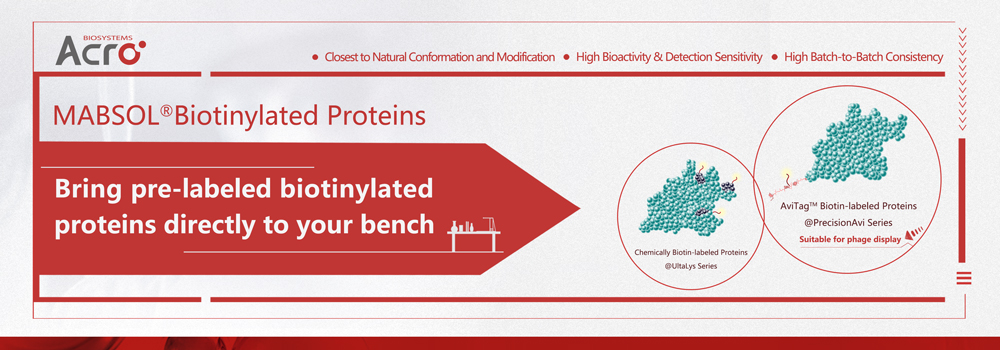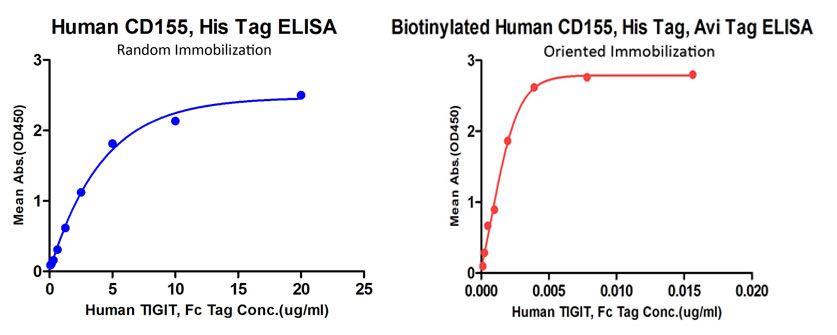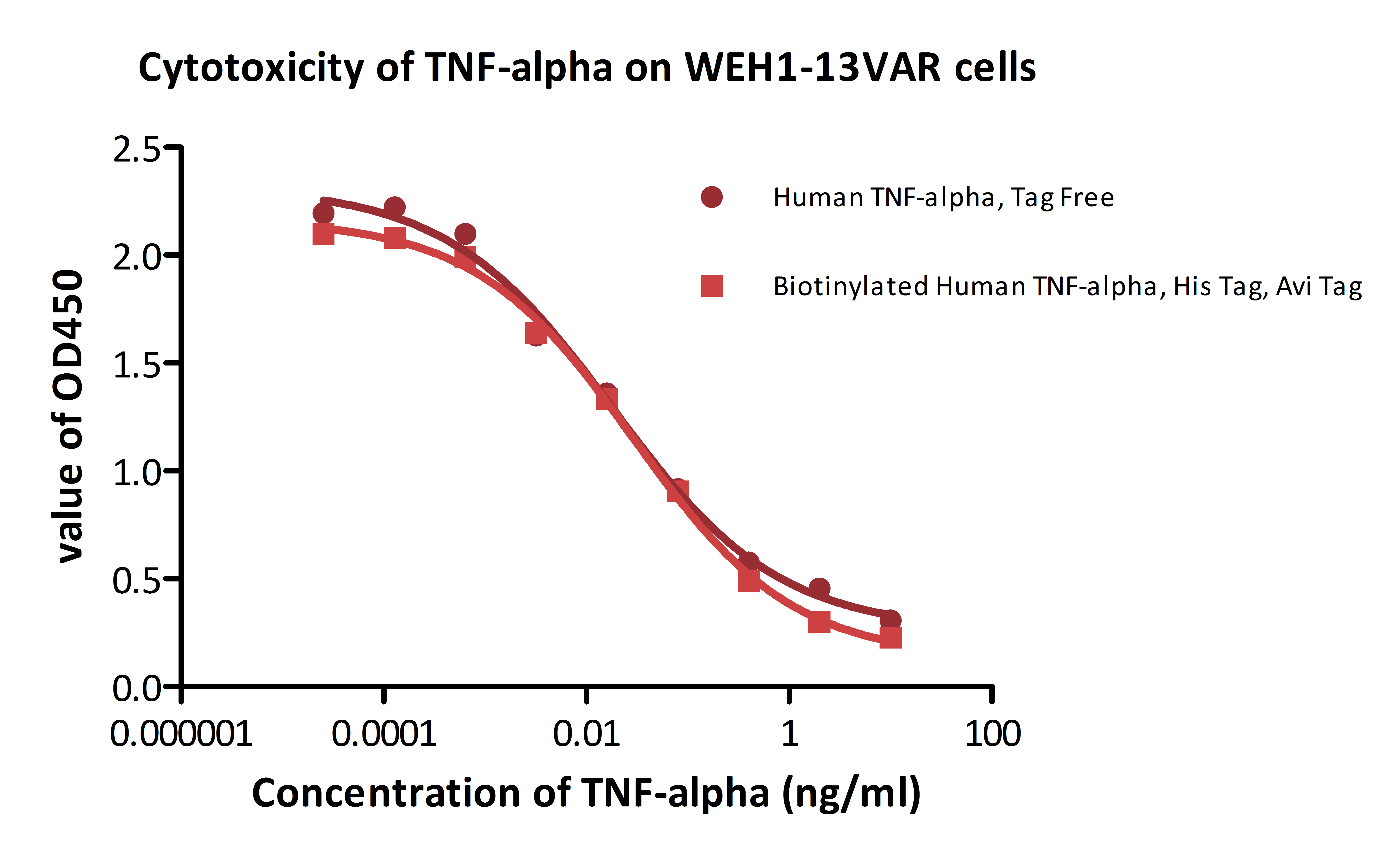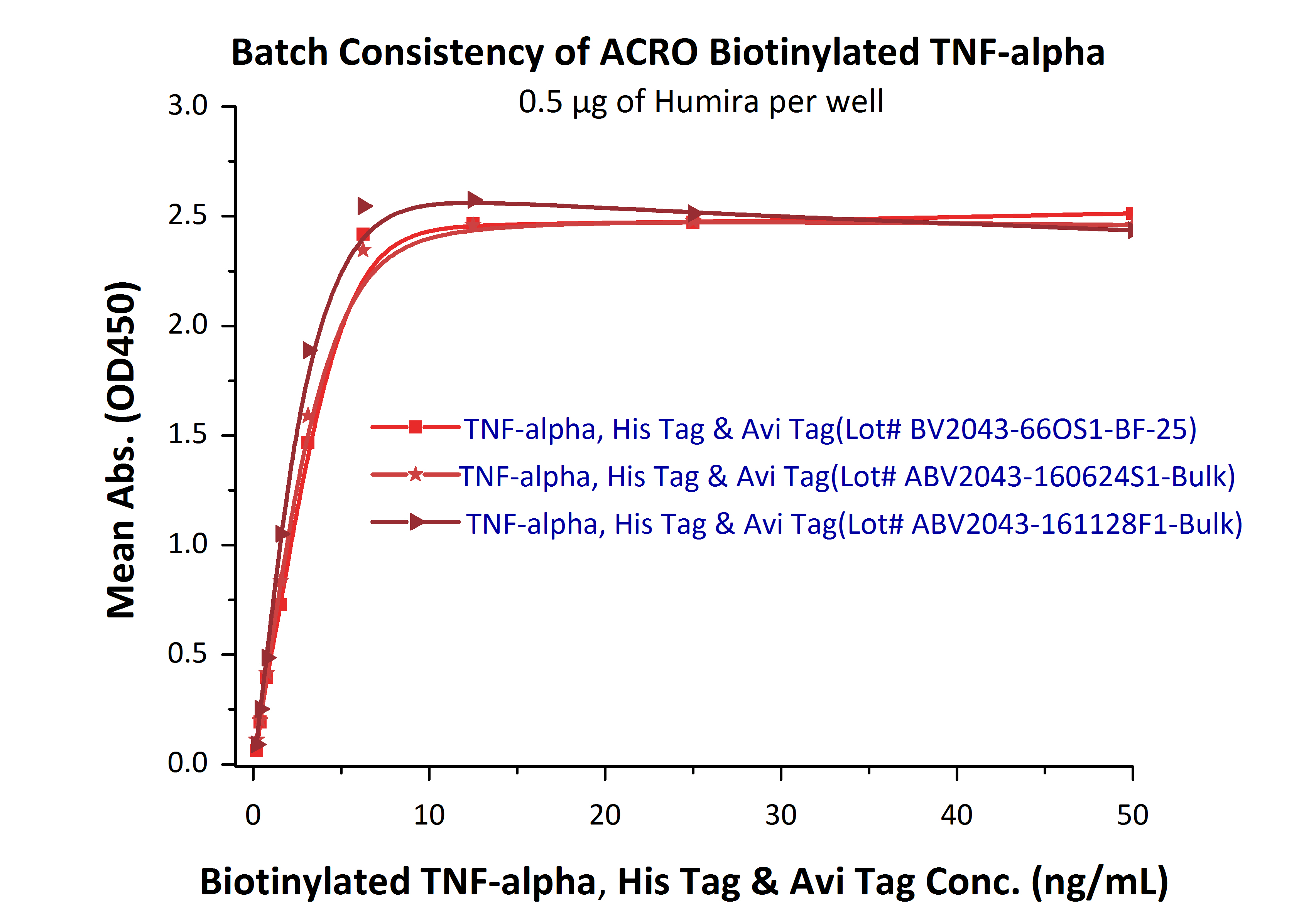 Limited Edition Golden Llama is here! Check out how you can get one.
Limited Edition Golden Llama is here! Check out how you can get one.  Limited Edition Golden Llama is here! Check out how you can get one.
Limited Edition Golden Llama is here! Check out how you can get one.
 Offering SPR-BLI Services - Proteins provided for free!
Offering SPR-BLI Services - Proteins provided for free! Get your ComboX free sample to test now!
Get your ComboX free sample to test now!
 Time Limited Offer: Welcome Gift for New Customers !
Time Limited Offer: Welcome Gift for New Customers !  Shipping Price Reduction for EU Regions
Shipping Price Reduction for EU Regions
> Biotinyliertes Protein

Die Wechselwirkung zwischen Biotin und Avidin/Streptavidin (SA) ist extrem stark und spezifisch, was es zu einem hervorragenden Werkzeug in der Proteinbiochemie macht. Die Erzeugung hochwertiger biotinylierter Proteine stellt jedoch eine große Herausforderung dar. Forscher stoßen häufig auf technische Probleme, darunter unzureichende Kennzeichnung, hohe Schwankungen von Charge zu Charge und unvorhersehbare Leistung. Darüber hinaus beeinflusst auch die Wahl der Biotinylierungsmethoden das Endergebnis erheblich. Jedes Zielprotein (Assay) hat seine eigenen einzigartigen biochemischen Eigenschaften und erfordert daher eine maßgeschneiderte Lösung.
Diese Störfaktoren erschweren es einzelnen Laboren, Biotin-Konjugate herzustellen und zu verwenden, während gleichzeitig nur wenige Produkte im Handel erhältlich sind. Um diese Lücke zu schließen, hat ACROBiosystems eine ausgewählte Sammlung vormarkierter und experimentell validierter biotinylierter rekombinanter Proteine entwickelt. Die Mabsol®-Sammlung biotinylierter Proteine umfasst mehr als einhundert häufig untersuchte Arzneimittelziele und Biomarker-Proteine.
Wir verwenden hochwertige rekombinante Proteine als Ausgangsstoffe, die der natürlichen Konformation und Modifikation am nächsten sind. Wir prüfen alle Alternativen gründlich, um die höchste Bioaktivität und Nachweisempfindlichkeit zu erreichen. Gleichzeitig wenden wir die strengstmöglichen Qualitätskontrollmaßnahmen an, um Schwankungen von Charge zu Charge auf ein Minimum zu reduzieren.
Die Sammlung biotinylierter Proteine von Mabsol® umfasst zwei einzigartige und sich ergänzende Produktserien: die PrecisionAvi-Serie, die auf der Avitag™ Technologie aufbaut(siehe vollständige Liste)und die UltraLys-Serie, die mit dem intern entwickelten chemischen Markierungsverfahren hergestellt wird(siehe vollständige Liste). Zur Herstellung dieser Produkte wird große Sorgfalt auf Details verwendet.
Die Produkte dieser Serie werden ausschließlich unter Nutzung der Avitag™ Technologie hergestellt. Kurz gesagt wird während der Konstruktion des Expressionsvektors ein einzigartiges 15-Aminosäuren-Peptid, das Avi-Tag, in das rekombinante Protein eingeführt. Der einzelne Lysinrest im Avi-Tag wird enzymatisch durch die E. coli-Biotin-Ligase BirA biotinyliert.
Diese enzymatische Einzelpunkt-Markierungstechnik bringt viele Vorteile für häufig verwendete Bindungsassays.
Die Biotinylierung findet nur am Lysinrest des Avi-Tags statt.
KEINE Beeinträchtigung der natürlichen Bindungsaktivitäten des Zielproteins.
Die Proteinorientierung ist einheitlich, sofern sie auf einer Avidin-beschichteten Oberfläche immobilisiert ist.
Die Produkte dieser Serie werden mit unserem intern entwickelten chemischen Markierungsverfahren hergestellt. Die primären Amine in den Seitenketten von Lysinresten und dem N-Terminus von Proteinen sind mit Biotinen konjugiert, was gewöhnlich zu einer mehrfachen Biotin-Bindung an ein einzelnes Proteinmolekül führt.
Höhere Nachweisempfindlichkeit
Eigens entwickelter chemischer Markierungssansatz
Die Produktion unserer rekombinanten Proteine, einschließlich der biotinylierten Proteine, erfolgt mit unserer urheberrechtlich geschützten HEKMax®-Expressionsplattform. Als Expressionswirte haben die human HEK293-Zellen im Vergleich zu anderen Zelltypen eine Reihe von Vorteilen, die in der folgenden Tabelle zusammengefasst sind.
Die Bioaktivität von biotinylierten Proteinen wird sowohl durch die Struktur des Proteins selbst als auch durch die Art und Weise, wie die Biotinylierung durchgeführt wird, bestimmt. Für jedes einzelne Protein testen wir mehrere Optionen von Tags und Biotinylierungsmethoden und bewerten die Produkte in einer Vielzahl von Bindungsassays. Nur diejenigen mit der besten Leistung werden für die Produktion ausgewählt. Abbildung 1 ist ein Beispiel für unsere internen Evaluierungsexperimente:

Fig. 1 Binding activity of different forms of biotinylated PD1 evaluated in a functional ELISA against rhPD-L1 (Cat. No. PD1-H5258).
Our biotinylated proteins demonstrate high bioactivity and superb detection sensitivity in different application. In functional ELISA, the biotinylated human TACI has high binding activity with BAFF as showed in Fig. 2. Interestingly, oriented immobilization of biotinylated CD155 offers much higher sensitivity than random immobilization of unconjugated CD155 as showed in Fig. 3. Fig.4 and Fig. 5 show that the biotinylated PD1 can be well applied to AlphaLISA to detect the binding activity with its ligand PD-L1 and PD-L2. The Fig. 6 and Fig. 7 show that the biotinylated protein can be easily used for determining the affinity between protein and therapeutic antibody in SPR assay. Also, the biotinylated proteins are often used in cell based assay, such as cytotoxicity assay and evaluation of CAR expression (Fig. 8 & Fig. 9).

Fig.2 Immobilized Human BAFF, Fc Tag, active trimer (Cat. No. BAF-H5261) at 1 μg/mL (100 μL/well) can bind Biotinylated Human TACI, Fc,Avitag (Cat. No. TAI-H82F6) with a linear range of 0.002-0.05 μg/mL.

Fig. 3 Comparison of oriented immobilization (biotinylated CD155 on precoated streptavidin plate, Cat. No. CD5-H82E3) and random immobilization (unconjugated CD155 direct coating on 96-well plate, Cat. No. CD5-H5223)binding to TIGIT( Cat. No. TIT-H5254). Oriented immobilization of biotinylated CD155 offers much higher sensitivity than random immobilization of unconjugated CD155.

Fig. 6 Immobilized biotinylated human VEGF165 (Cat. No. VE5-H82Q0) on CM5 Chip via streptavidin, can bind Avastin with an affinity constant of 0.417nM as determined in SPR assay (Biacore T200).

Fig.7 Loaded Biotinylated Human PD-1, Avitag,His Tag (recommended for biopanning) (Cat. No. PD1-H82E4) on SA Biosensor, can bind Human PD-L1, His Tag (HPLC verified) (Cat. No. PD1-H5229) with an affinity constant of 2.4 μM as determined in BLI assay (ForteBio Octet Red96e).

Fig. 8 Recombinant human TNF-alpha (Cat. No. TNA-H82E3) induces cytotoxicity effect on the WEH1-13VAR cells in the presence of the metabolic inhibitor actinomycin D. The EC50 for this effect is 0.014-0.029 ng/ml. The result shows that the biotinylated human TNF-alpha is consistent with naked TNF-alpha in cytotoxicity assay.
We routinely apply rigorous quality control measures to ensure consistent performance of our products. Newly produced products are subjected to side-by-side comparison with our internal standard in a variety of assays. Only those within an acceptable margin of difference are allowed to be released. As demonstrated in Fig. 9, three different batches of biotinylated hTNF-alpha (Cat. No. TNA-H82E3) are tested and compared using a standard ELISA analysis against Adalim*mab, the result shows that the batch variation among the tested samples is negligible. The batch-to-batch conformance is also good as displayed in cell based assay (Fig. 10).

Fig. 10 In the above ELISA analysis, three different lots of biotinylated hTNF-alpha (Cat. No. TNA-H82E3) were used detect immobilized Adalim*mab (0.5 ug/ml). The result showed that the batch variation among the tested samples is negligible.

Fig. 11 Recombinant biotinylated human TNF-alpha (Cat. No. TNA-H82E3) induces cytotoxicity effect on the WEH1-13VAR cells in the presence of the metabolic inhibitor actinomycin D. The EC50 for this effect is 0.029-0.052 ng/ml.
Authors: MacLeod DT et al.
Journal: Mol Ther 2017
Product: biotinylated Human CD19(Cat. No. CD9-H8259)
Application: Flow Cytometry
Authors: El Amrani M et al.
Journal: J Chromatogr A 2016
Product: biotinylated human recombinant TNF-alpha(Cat. No. TNA-H8211)
Application: ELISA
Authors: Kim Young Min et al.
Journal: United States Patent Application 20160136300 2016
Product: ErbB2(Cat. No. HE2-H822R)
Application: ELISA
Authors: Pooja Sabhachandani et al.
Journal: Microchimica Acta 2015
Product: biotinylated human TNF-α(Cat. No. TNA-H8211)
Application: Microsphere-based assay
Authors: YU et al.
Journal: United States Patent Application 20140155285 2014
Product: biotinylated TNFα(Cat. No. TNA-H8211)
Application: Flow Cytometry
This web search service is supported by Google Inc.
